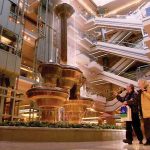The world’s first passenger elevator didn’t look like much compared to the finished articles that can be found in today’s buildings.
Launched at the Haughwout Department Store in central New York back in 1857, it was viewed as more of a tourist attraction, propelled by a steam engine and travelling at highly inefficient speeds of just 40 feet per minute.
The need for elevators has somewhat changed since this time, no longer considered a luxury or novelty, but rather an essential function of towering structures.
However, while it is true that elevators have progressed in keeping with the upward curve of urbanisation, their operational concept has remained largely unchanged, leading to architectural headaches in recent years.
“The elevator industry has been around for 160 years, but it hasn’t deviated much. Most elevators only move in vertical shafts, but the world – and cities specifically – have adapted. Traditional elevators are fast becoming a bottleneck for the building industry. They have limited capacity for moving people, and they occupy excessively inefficient floor space.”
For Michael Cesarz, an established architect by trade, the question of mobility issues in cities was growing with a lack of the innovative thinking required to address such challenges. This was his motivation behind joining thyssenkrupp Elevator.
“Our first attempt to pioneer new thinking in this space came in 2002, with the TWIN system,” he recalls. “With two cabins per shaft and a 30 percent increase in transport capacity, combined with a 30 percent reduction in the elevator footprint in buildings, it was an achievement in its own right. But MULTI takes this further.
“When I saw the concept, I was captivated. It sparked my imagination, and I knew I had to be part of the team.”
The innovative answer to urban mobility
So, what is MULTI?
For Cesarz, now CEO of the MULTI division, it presents infinite possible solutions to the challenges posed by outdated elevator technologies. Removing traditional suspension ropes, the technology instead combines specialised motors, allowing cabins to move not only vertically, but also horizontally.
“You may have heard of paternoster elevators – systems that consists of a chain of open compartments,” he reveals. “They move slowly in a loop, up and down inside a building without stopping.
“This circular system is central to MULTI. To enable modern elevator cabins to move in a loop, MULTI will use rope-less linear motor technology to operate elevators that can move sideways. The mechanism holding the cabin can rotate 90 degrees, allowing them to move along a new track.”
The core difference between MULTI and the paternoster systems, however, is speed. MULTI’s elevators will be able to travel at five metres per second, and with many multiple cabins in a loop, the system will enable near-constant access to an elevator cabin – approximately every 15 seconds.
“With this system, shaft transport capacities will increase by 50 percent and elevator footprints in buildings can be reduced by up to 50 percent,” Cesarz adds.
Considering this, MULTI has the potential to benefit a number of verticals, and horizontals, whether it’s saving space in skyscrapers that can be used to house more apartments or offices or opening up new directions of travel in metro networks.
“There is expected to be a 2.5 billion increase in urban population numbers in the next three decades,” Cesarz adds. “With severe restrictions on space, taller buildings have proven to be the most economically and environmentally viable developments to accommodate rapidly growing populations. They occupy less land, leaving essential space for green areas, and they also allow for centralised intelligent control of energy and resources.
“As such, buildings are surpassing expectations in terms of scale. In 2000, the average height of the world’s 50 tallest buildings was 315 metres, while in 2013, that same average reached 390 meters; a 25 percent increase in just over a decade.”
Against this backdrop, efficient mobility in buildings will only become a more pressing matter, and MULTI may very well may be the innovative answer that is needed.
Endless possibilities
2019 will see thyssenkrupp beginning to more actively market MULTI, owed to its Elevator’s Rottweil-based test tower that has progressively powered the technological developments.
This facility is readily equipped with everything needed to trial sophisticated elevator systems, featuring nine test shafts that are dedicated to both TWIN and MULTI and a 240-tonne pendulum that can simulate vibrations and adverse weather conditions, enabling engineers to conduct real-life test runs.
“On a side note,” Cesarz adds, “the tower boasts Germany’s highest visitor platform, with a 360-degree panoramic view, and on good days you can see the Swabian Alb and Swiss Alps. I would highly recommend a visit.”
What’s more, the Rottweil tower is situated close to the firm’s elevator plant in Neuhausen, less than 100 kilometres north by road. Here, roughly 1,500 thyssenkrupp Elevator experts are building next-generation industry solutions.
“Being part of a wider group opens us up to different kinds of innovation and generates new thinking, which is invaluable,” Cesarz explains. “We’re able to gather knowhow and expertise from various branches and individuals.
“One example is our expertise in linear motor technology. This was driven by other innovators in the thyssenkrupp group, specifically those responsible for developing technology for the magnetic levitation trans-rapid train. This technology fed into the development of MULTI and so, without it, the elevator may not have existed.”
With the prototype in place as a result of these innovations and collaborations combined, MULTI seeks to transition into commercial rollout moving forward.
“We have already accumulated many substantial project leads from all over the world, from passenger transport in airport terminals with MULTI running like a sky train above the pedestrians to use in skiing areas,” Cesarz concludes. “It’s far more than just an elevator – the possibilities are endless.”



















